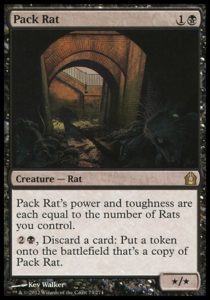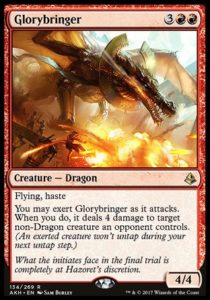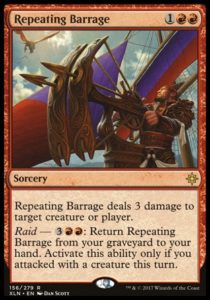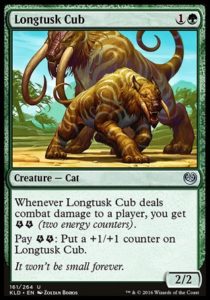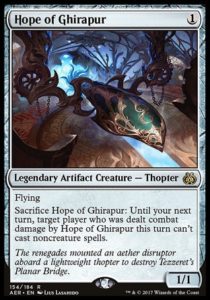Last week, we discussed the state of Limited. The quality of large sets has somewhat diminished since the beginning of the two block paradigm while the quality of small sets has substantially improved leading up to their retirement. Today, I’d like to delve into perhaps the biggest problem in contemporary Limited and one of the worst feelings in Magic: hopelessness.
Nothing you can do but Die
Picture this. You’ve got a pretty nice deck—nothing too fancy, just some decent threats, synergy, and removal—y’know, a solid B+. You sit down to play and your opponent swiftly jams a threat that’s difficult to remove or interact with and can win the game by itself. You don’t have the answer right then and there. The only way out is racing, but your opponent’s one threat races better than most of your deck. So, you die. Most of us have probably been here before.
Some of the most egregiously powerful cards in Magic are like this. Pack Rat on turn two was nearly unstoppable in Return to Ravnica draft. The Scarab God and Glorybringer were insanely powerful and resilient threats in Amonkhet and Hour of Devastation Limited. Umezawa’s Jitte and Jace, the Mind Sculptor continue to single-handedly wreck opponents in Legacy.
These cards are the bombiest of bomb rares, cards that can heavily tilt the balance of a game despite massive skill differentials or board states. This volatility is by design and is one Magic’s strengths: part of what makes the game great is the uncertainty made possible by the existence of powerful cards. However, there are different gradations of bomb rares.
Play Patterns and Hope
Consider Etali, Primal Storm, Glorybringer, and Repeating Barrage. These three bombs can all take over the game by themselves but have different kinds of play patterns.
Etali, Primal Storm is the weakest of the bunch (even setting aside it being the most expensive). It can be answered by instant or sorcery speed removal. It can die in combat rather easily (though after providing a potentially massive benefit). It can be answered with auras as well as spells. It has to wait a turn before providing any benefit.
Glorybringer is a much more powerful card. It provides value the turn it comes down by killing a threat (or providing immediate pressure). If it’s able to kill a creature (which it usually is), then answering it with sorcery speed removal still leaves the opponent down a card—they lost a medium-sized creature and spent a premium removal spell. Glorybringer can only be efficiently stopped by countermagic or an instant speed removal spell, but not one like Divine Verdict).
Repeating Barrage is the slowest of the three cards, but the hardest to stop. It’s resilient to countermagic and discard. It can be temporarily disrupted by creature removal, but it’s nearly impossible to kill all of your opponent’s creatures or interact with their graveyard in Rivals of Ixalan Limited. The only way to stop it is to kill your opponent before the game goes long enough and they grind out sufficiently value.
Unstoppable, Creeping Death
Of the three aforementioned bombs, I think Repeating Barrage is the worst-designed. Yes, Glorybringer is obscenely powerful and probably should have been a mythic for the sake of Limited balance, but Glorybringer ends games quickly. Sure, it can feel lousy losing to a Glorybringer off the top, but you’re not stuck playing an impossible game as your opponent slowly kills you. Moreover, Glorybringer is a creature, the easiest type of permanent to interact with—in Limited (and Constructed), you’re supposed to have some means of killing your opponent’s creatures. Repeating Barrage, on the other hand, is nearly impossible to stop and kills slowly. It wants to play a protracted game where it grinds out value (though yes, it sometimes is just two bolts to the face) as one player steadily falls farther and farther behind, but has to keep playing because their opponent might run out of threats.
Now, I don’t mean to rag on Repeating Barrage too hard. I think it’s a fine, fun twist on Hammer of Bogardan. There’s something fun about slow, resilient engines that can take over the game. However, such cards are deeply problematic when they appear in anything more than tiny numbers. And I’ve been thinking about such cards because Rivals of Ixalan has a disproportionately large number of them. RoI isn’t just a bomb-heavy format like Scars of Mirrodin or Fate Reforged: it’s full of uninteractive, grindy cards that are incredibly difficult to play around.
Tetzimoc, Primal Death, Profane Procession, Gold-Forge Garrison—all take over the game by themselves, all function from zones that are difficult to interact with (and impossible for some colors to stop), and all are rare.
It’s reasonable for a set to include some insanely powerful mythic rares like Rekindling Phoenix or Vraska, Relic Seeker, and it’s fine for a set to have extremely expensive rare finishers like Zetalpa, Primal Dawn. It’s even reasonable for a set to have a difficult-to-interact-with bomb like Citadel Siege. However, Rivals of Ixalan has several rares that basically say, “I get to cast Plague Wind, I get to show you that I’m casting it in advance, I don’t need to hit my ninth land drop to get there, and it even comes with a body attached.”
These cards aren’t even plants for Constructed, they simply exist to make more games of Limited end in slow, hopeless slogs. I think one of these cards is more than sufficient for a Limited format, but this many is needlessly excessive. Rivals is a good Limited format in spite of the density of these rares, not because of it.
Dead on Turn Two
The core reason I’ve been so lukewarm on recent large set Limited formats is the sheer density of common and uncommon threats that can create hopeless situations. A turn-two Longtusk Cub on the play isn’t as egregious as a turn-two Pack Rat, nor as difficult to answer (though common removal has gotten appreciably weaker since RtR, particularly in large sets). But if you can’t stop it immediately, you basically lose.
Gust Walker, One With the Wind, Trial of Solidarity, Renegade Freighter, even Bloodrage Brawler and Wanted Scoundrels are all undercosted, must-answer threats that decide games one way or the other. Even if removal is strong (as it was in Amonkhet), the sheer density of must-stop threats taxes it too heavily for it to keep pace. After all, an answer without a threat doesn’t push the game to a conclusion, but a threat without an answer does.
While the design of Ixalan, Amonkhet, and Kaladesh is quite different, they all share the hopeless feeling of, “Oh, I’m dead” on turn three based purely on common and uncommon threats. It doesn’t matter to the losing player that they’re losing to an aura, vehicle, energy-based threat, or exerting sand wizard, what matters is that the feeling of hopelessness behind their loss remains constant. Magic can design as different formats as it likes, but if they engender the same feelings, particularly the same negative feelings, then the design differences don’t really matter.
I end this week on the same note as I did last week: cautious optimism. I believe that the balance between common creatures and removal is shifting and that the pendulum will swing the other way. I believe that both Play Design and the restructuring of how R&D operates will be boons for Dominaria and all sets going forward. Magic is ultimately a game designed by people who are passionate about it, want it to be the best game it can be, and who learn from both their mistakes and successes. Here’s looking forward to what comes next.
And, as always, thanks for reading.
—Zachary Barash
Zachary Barash is a New York City-based game designer. He works for Kingdom Death: Monster, has a Game Design MFA from the NYU Game Center, and does freelance game design. When the stars align, he streams Magic.
His favorite card of the month is Impale. It’s solid, it’s simple, it’s clean, and it’s kind of perfect for Limited.



